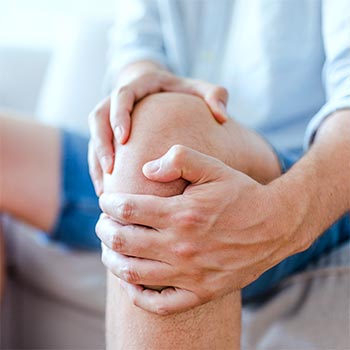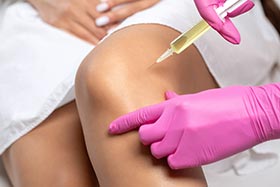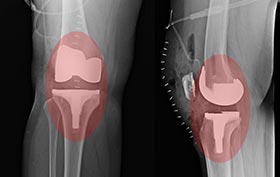Knee Pain
AN MEDICAL is dedicated to provide a wide range of medical services for all age groups. Our goal is to provide comprehensive, accessible, affordable healthcare and to promote healthy living and well-being in our community.

KNEE PAIN
Osteoarthritis of the knee is a common joint condition that affects the knee joint, causing pain and stiffness. It occurs when the protective cartilage that covers the ends of the bones in the knee joint gradually wears away, resulting in the bones rubbing against each other. This can lead to pain, swelling, and difficulty moving the knee.
Here are some key points to understand about osteoarthritis of the knee:

CAUSES
The exact cause of knee osteoarthritis is not known, but it often develops as a result of aging, wear and tear on the joint, and repetitive stress on the knee. Factors such as obesity, previous knee injuries, genetics, and certain occupations or sports activities can also contribute to its development.

SYMPTOMS
The most common symptom of knee osteoarthritis is knee pain, which may be felt as a dull ache or sharp pain. The pain is often worse after activity or prolonged periods of inactivity, such as sitting or sleeping. Stiffness, swelling, and a limited range of motion in the knee joint are also common.
DIAGNOSIS
A diagnosis of knee osteoarthritis is typically made based on a combination of symptoms, a physical examination, and medical imaging tests such as X-rays or MRI scans. These tests help doctors assess the condition of the knee joint and rule out other possible causes of the symptoms.
TREATMENT
While there is no cure for knee osteoarthritis, there are several treatment options available to manage the symptoms and improve quality of life.
• Medications: Over-the-counter pain relievers like acetaminophen or nonsteroidal anti-inflammatory drugs (NSAIDs) can help alleviate pain and reduce inflammation.
• Physical therapy: Specific exercises and stretches can help strengthen the muscles around the knee joint, improve flexibility, and reduce pain.

• Assistive devices: The use of assistive devices like canes, braces, or shoe inserts can provide support and relieve pressure on the knee joint.
• Injections: Corticosteroid injections or hyaluronic acid injections into the knee joint may be recommended to provide temporary pain relief.
• Lifestyle changes: Maintaining a healthy weight, regular exercise that is easy on the knees (such as swimming or cycling), and avoiding activities that worsen the pain can help manage the symptoms.

• Surgery: In severe cases, surgical options such as arthroscopy (a minimally invasive procedure to clean the joint), partial knee replacement, or total knee replacement may be considered. These surgeries aim to repair or replace the damaged joint surfaces.
It is important to consult a healthcare professional for an accurate diagnosis and personalized treatment plan if you suspect you have knee osteoarthritis. Come speak to us at AN Medical Clinic for a detailed assessment.
